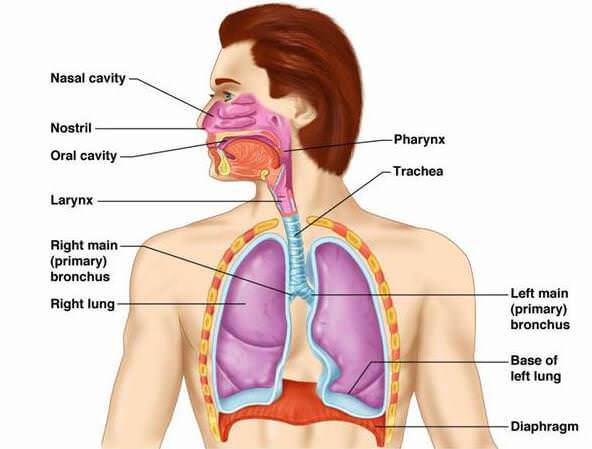The human respiratory system is made up of many organs such as nose, nasal cavity, pharynx, larynx, trachea, bronchi and a pair of lungs. But, lungs are the main respiratory organs where exchange of gases takes place. Following is the detail of human respiratory system.

1. Nasal cavity
In human beings air containing oxygen enter the body through nose. There are present two holes in our nose called nostrils. The nostrils opens behind in the nasal cavity. The nasal cavity lies above the buccal cavity. The function of nasal cavity is to moisten, warm and trap dust particles present in the air coming in it through nostrils. The nasal cavity opens behind in the pharynx.
2. Pharynx
Pharynx is a common passage for both the respiratory and digestive system. It leads into the larynx (voice box).
3. Larynx
It is also known as voice box. It lies at the top of trachea. The pharynx opens into the larynx through a slit like opening called glottis. The glottis is protected by a leaf shaped flap of cartilage called epiglottis. Epiglottis covers the mouth of glottis when we swallow food, so that food may not enter the trachea.
There is present a pair of vocal cords inside the larynx. When air passes through the larynx, vibrations are produced in the vocal cords and it results in production of sound.
4. Trachea
It is also known as wind pipe. It is 10-12 cm. long tube with a diameter of 2-3 cm. trachea is supported by 15-20 cartilaginous rings. These rings prevent trachea from collapsing when no air is present in it and also provides flexibility and strength.
At its lowerend the trachea divides into two smaller tubes called bronchi (singular bronchus)which enters the right and left lungs. The walls of bronchi are also supported by cartilaginous rings. In the lungs, each bronchus further divides into still smaller tubes called bronchioles. At the ends of each bronchiole there is present a cluster of tiny and thin walled sacs called alveoli. Each alveoli is surrounded by a network of very fine blood capillaries.
5. Lungs
In humans, a pair of lungs is present in the thoracic cavity, one on each side of the heart. These are called right lung and left lung respectively. The right lung is larger than the left lung. The right lung has three lobes and two fissures. While, the left lung has two lobes and only one fissure. Both the lungs are covered by two membranes called pleura. The fluid present in between these two membranes is called pleural fluid. It protects the lungs from mechanical injuries.
Test Your Understanding and Answer These Questions:
- State the functions of epiglottis.
- Name the membranes covering the lungs.
- What is the function of air sacs in lungs?
- What are vocal cords? What is their function?
- Draw the respiratory system of human beings.
- Which is the main respiratory organ in human beings?
- Why do the walls of trachea not collapse when there is less air in it?
- Out of right and left lung found in human which is larger in size?
- Give differences between right lung and left lung of human beings.
